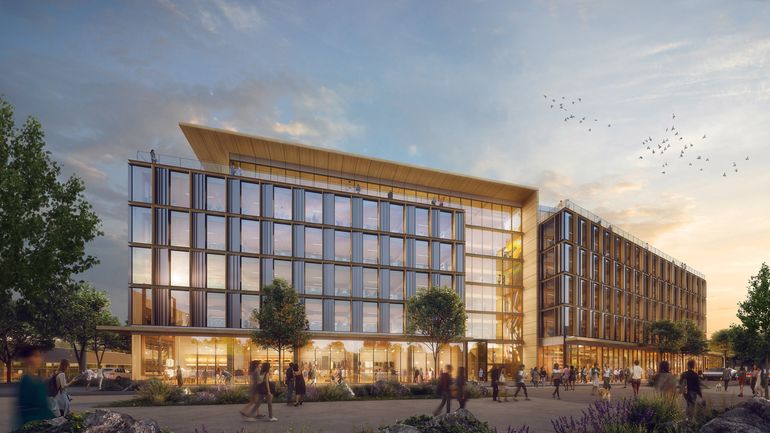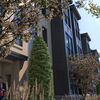Rock Row developers to build Maine’s first mass timber office building
 COURTESY / EYP ARCHITECTS AND ENGINEERING
A rendering shows the cross-laminated timber retail and office building planned for the Rock Row mixed-use development in Westbrook.
COURTESY / EYP ARCHITECTS AND ENGINEERING
A rendering shows the cross-laminated timber retail and office building planned for the Rock Row mixed-use development in Westbrook.
The first commercial office building in Maine that will primarily use cross-laminated timber will be funded in part by a $250,000 grant from the U.S. Department of Agriculture.
The 150,000-square-foot office building, at 100 Rock Row, will include 30,000 square feet of retail space on the first floor.
The project will showcase the unique material and its construction, provide training in the use of the product and will be the first to implement new building codes to facilitate its adoption.
Waterstone Properties Group was awarded the money, which came from the department’s wood innovations grant program; the architect is EYP Architects & Engineering in Albany, N.Y.
According to Waterstone’s marketing information, CLT, which has been used in Europe for years, is a solid-engineered wood panel that consists of multiple layers of dimensional lumber that is stacked and bonded at a 90-degree angle.
Waterstone’s goal is to help pioneer the commercial adoption of cross-laminated timber and support the attraction of a CLT manufacturer to Maine. The use of sustainably sourced CLT is also expected to reduce the project’s carbon footprint when compared to traditional construction materials.
“This project will promote the economic future of Maine’s timber industry and environmental health of communities by helping to establish the market for a regenerative and sustainable building material that also has a tremendous impact on the health and wellness of employees,” Josh Levy, Waterstone’s principal, said in a news release.
“By replacing traditional building materials such as steel and concrete, CLT represents regenerative building material that reduces the carbon footprint of the building materials by up to 30%, offering the potential to even deliver a carbon negative footprint when one takes into account the carbon that is sequestered by the trees when sourced from sustainably managed forests.”
Compared to masonry, concrete and steel construction, CLT offers advantages that are said to include 66% less in energy costs, greater thermal comfort, a superior level of healthy fresh air, greater sound absorption and noise cancellation, continuous air tight insulation, and greater fire protection and seismic performance.
According to Levy, a recent study found that benefits to mass timber that include “biophilics,” a building concept that increases occupant connectivity to the natural environment. In this case, he said, there’s a potential to reduce employees stress levels by 39% and increase concentration by 27%.
Rock Row has been expanding following the completion of the grocery-anchored retail phase of the project with the state's second Market Basket and also features brands such as Starbucks, Orange Theory, Crumbl Cookies, and local businesses such as Big Fin Poke and Cowbell Burger.
The next phases include a medical and research campus anchored by New England Cancer Specialists, residential housing, a retail and restaurant row, an event space, a transit hub, and CLT office building.
The complex attracts over 2 million visitors annually. Waterstone estimated the development, once completed, will attract 6 million visitors a year and employ over 4,000 people.
Said Michael Foley, mayor of Westbrook, “Rock Row is already having a significant positive economic impact that is bringing jobs and opportunity to Westbrook, and we look forward to a continued partnership with Waterstone to bring this shared vision to fruition.”
The wood innovations grant program aims to expand the use of wood products, strengthen emerging wood markets, and support management to improve forest health and resilience. The grants, comprising $32 million in federal funds from the USDA Forest Service and $93 million in partner funds, were awarded to 99 projects across the country.









0 Comments